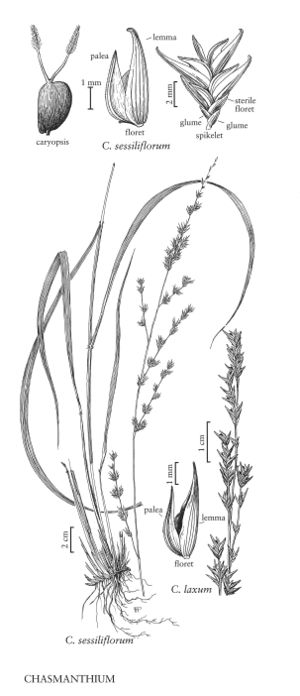Difference between revisions of "Chasmanthium laxum"
FNA>Volume Importer |
imported>Volume Importer |
||
| (4 intermediate revisions by 2 users not shown) | |||
| Line 4: | Line 4: | ||
|publications= | |publications= | ||
|common_names=Slender chasmanthium | |common_names=Slender chasmanthium | ||
| + | |special_status={{Treatment/ID/Special_status | ||
| + | |code=E | ||
| + | |label=Endemic | ||
| + | }} | ||
|basionyms= | |basionyms= | ||
|synonyms={{Treatment/ID/Synonym | |synonyms={{Treatment/ID/Synonym | ||
|name=Uniola laxa | |name=Uniola laxa | ||
| − | |authority= | + | |authority= |
| + | |rank=species | ||
}} | }} | ||
|hierarchy=Poaceae;Poaceae subfam. Centothecoideae;Poaceae tribe Centotheceae;Chasmanthium;Chasmanthium laxum | |hierarchy=Poaceae;Poaceae subfam. Centothecoideae;Poaceae tribe Centotheceae;Chasmanthium;Chasmanthium laxum | ||
| Line 19: | Line 24: | ||
-->{{Treatment/Body | -->{{Treatment/Body | ||
| − | |distribution=Md.;N.J.;Okla.;Miss.;Tex.;La.;Pa.;Mo.;Del.;Ala.;D.C;Tenn.;N.C.;S.C.;Va.;Ark.;Ga.;N.Y.;Ky.;Fla. | + | |distribution=Md.;N.J.;Okla.;Miss.;Tex.;La.;Pa.;Mo.;Del.;Ala.;D.C.;Tenn.;N.C.;S.C.;Va.;Ark.;Ga.;N.Y.;Ky.;Fla. |
| − | |discussion=<p>Chasmanthium laxum is almost completely sympatric with C. sessiliflorum in the southeastern United States, growing in similar habitats but extending farther into sphagnous stream heads, pine flatwoods, and pine savannahs. Yates (1966b) reported seeing putative, naturally occurring hybrids between Chasmanthium ornithorhynchum and C. laxum along streams of the outer coastal plain of Mississippi and Louisiana. In general appearance, the hybrids resemble C. laxum, their most striking difference being the enlarged, sterile spikelets.</p> | + | |discussion=<p><i>Chasmanthium laxum</i> is almost completely sympatric with <i>C. sessiliflorum</i> in the southeastern United States, growing in similar habitats but extending farther into sphagnous stream heads, pine flatwoods, and pine savannahs. Yates (1966b) reported seeing putative, naturally occurring hybrids between <i>Chasmanthium ornithorhynchum</i> and <i>C. laxum</i> along streams of the outer coastal plain of Mississippi and Louisiana. In general appearance, the hybrids resemble <i>C. laxum</i>, their most striking difference being the enlarged, sterile spikelets.</p> |
|tables= | |tables= | ||
|references= | |references= | ||
| Line 29: | Line 34: | ||
-->{{#Taxon: | -->{{#Taxon: | ||
name=Chasmanthium laxum | name=Chasmanthium laxum | ||
| − | |||
|authority=(L.) H.O. Yates | |authority=(L.) H.O. Yates | ||
|rank=species | |rank=species | ||
| Line 36: | Line 40: | ||
|basionyms= | |basionyms= | ||
|family=Poaceae | |family=Poaceae | ||
| − | |illustrator=Linda A. Vorobik | + | |illustrator=Linda A. Vorobik;Hana Pazdírková |
| − | |distribution=Md.;N.J.;Okla.;Miss.;Tex.;La.;Pa.;Mo.;Del.;Ala.;D.C;Tenn.;N.C.;S.C.;Va.;Ark.;Ga.;N.Y.;Ky.;Fla. | + | |illustration copyright=Utah State University |
| + | |distribution=Md.;N.J.;Okla.;Miss.;Tex.;La.;Pa.;Mo.;Del.;Ala.;D.C.;Tenn.;N.C.;S.C.;Va.;Ark.;Ga.;N.Y.;Ky.;Fla. | ||
|reference=None | |reference=None | ||
|publication title= | |publication title= | ||
|publication year= | |publication year= | ||
| − | |special status= | + | |special status=Endemic |
| − | |source xml=https:// | + | |source xml=https://bitbucket.org/aafc-mbb/fna-data-curation/src/200273ad09963decb8fc72550212de541d86569d/coarse_grained_fna_xml/V25/V25_1039.xml |
|subfamily=Poaceae subfam. Centothecoideae | |subfamily=Poaceae subfam. Centothecoideae | ||
|tribe=Poaceae tribe Centotheceae | |tribe=Poaceae tribe Centotheceae | ||
Latest revision as of 18:55, 11 May 2021
Culms 40-130 cm, to 1 mm thick at the nodes, unbranched, leafy for 50% of their height. Sheaths glabrous; collars glabrous; ligules 0.2-0.4 mm, entire; blades (8)15-35(40) cm long, 3-8(11) mm wide, linear-lanceolate, usually glabrous, sometimes sparsely pilose adaxially. Panicles (7)12-35(47) cm, contracted, erect; branches ascending to appressed; axils of panicle branches glabrous; pedicels 0.5-2.5 mm. Spikelets 4-9 mm long, 2-6 mm wide, with (2)3-5(7) florets, lower 1(2) florets sterile, fertile florets divergent to 45°. Lower glumes 1.3-3 mm, (1)3-5-veined; upper glumes 1.3-2.5 mm, 3-5-veined; calluses glabrous; fertile lemmas 2.9-4.5 mm, straight, 3-7-veined, keels not winged, apices scabridulous; paleas 2.3-3 mm; anthers 1.3-1.5 mm, the length invariant within a spikelet. Caryopses 1.9-2.2 mm, exposed at maturity. 2n = 24.
Distribution
Md., N.J., Okla., Miss., Tex., La., Pa., Mo., Del., Ala., D.C., Tenn., N.C., S.C., Va., Ark., Ga., N.Y., Ky., Fla.
Discussion
Chasmanthium laxum is almost completely sympatric with C. sessiliflorum in the southeastern United States, growing in similar habitats but extending farther into sphagnous stream heads, pine flatwoods, and pine savannahs. Yates (1966b) reported seeing putative, naturally occurring hybrids between Chasmanthium ornithorhynchum and C. laxum along streams of the outer coastal plain of Mississippi and Louisiana. In general appearance, the hybrids resemble C. laxum, their most striking difference being the enlarged, sterile spikelets.
Selected References
None.
